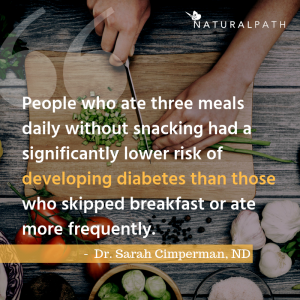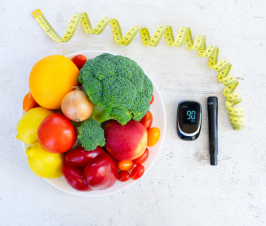Spring is a season of renewal. Over the winter, as our bodies have stored energy, they’ve also stored environmental toxins. Now is the time to eliminate them. True detoxification involves several enzymes, hormones, and organs, including the liver, kidneys, gastrointestinal tract, skin, lungs, adipose tissue, and lymphatic system. Comprehensive detox programs like the one I wrote about in my book, The Prediabetes Detox,1 [http://www.drsarahcimperman.com/the-prediabetes-detox.html] and the ones I put together for my patients, can be a big commitment. They usually involve diet changes, supplements, exercise, hydrotherapy, saunas, relaxation, and extra sleep. Not everyone can do all of this. But we all can do some of this, and diet is a great place to start. Here are my top 5 diet changes for a fresh start this spring.
 #1 | Eat Green
#1 | Eat Green
Eating plenty of green vegetables is an important part of detoxification. Green plants are particularly rich in chlorophyll, a compound that reduces the absorption of toxic chemicals from the environment and facilitates their removal from the body.2 Green plants are also good sources of fiber, which can help to lower blood sugar in people with diabetes3 and improve elimination through regular bowel movements. Green vegetables should make up at least half of every meal. It’s especially easy in the spring because many seasonal foods are green: asparagus, peas, spring onions, ramps, fiddle heads, and a wide variety of salad greens and fresh herbs. Other good choices are cruciferous vegetables because they are a rich source of sulfur-containing compounds that support the liver’s role in detoxification.4 These include arugula, bok choy, broccoli, Brussels sprouts, cabbage, collard greens, kale, mustard greens, Swiss chard, and watercress.
#2 | Eliminate Sweets and Starches
Most environmental toxins are fat-soluble and they’re stored inside fat cells. When blood sugar levels are low, the body burns fat for energy, releasing environmental toxins along with fatty acids into the blood stream. Once toxins circulate to the liver, they undergo chemical reactions that transform them into water-soluble compounds the body can excrete. When blood sugar levels are high, the opposite happens: fatty acids and toxins remain trapped inside fat cells, so they can’t be excreted. The best way to prevent high levels of blood sugar is to avoid eating sugar. In this case, “sugar” means glucose and it refers to both sweets and starches. It includes all sweeteners (natural and artificial), foods made with flour (bread, pastries, crackers, breakfast cereals, pasta), all grains (including rice, oatmeal, corn), starchy fruits and vegetables (bananas, potatoes, winter squashes), processed fruit (jam, jelly, dried fruit), milk, and soft drinks like extracted juices, flavored water, soda, energy drinks, and sports drinks.
#3 | Stop Snacking
Eating three regular meals each day and avoiding snacks will ensure extended periods of time when blood sugar levels are low and the body is burning fat for energy. Avoiding snacks isn’t just good for detox; it may also reduce your risk of diabetes. A study from Harvard University that followed almost thirty thousand people for sixteen years found that people who ate three regular meals each day and did not snack had a significantly lower risk of developing diabetes than those who skipped breakfast and those who ate more frequently, regardless of body mass index and food quality.5
#4 | Fast 12 Hours Overnight
Fasting for twelve hours overnight also keeps blood sugar levels low for long periods of time. And the benefits may extend beyond detox. Studies show that intermittent fasting can boost energy, reduce inflammation, and protect against cellular damage.6 It’s already being used to treat cancer, obesity, metabolic syndrome, hypertension, asthma, and rheumatoid arthritis. Researchers believe that intermittent fasting also has the potential to delay aging and prevent disease. Not everyone is a good candidate, including people with blood sugar problems like hypoglycemia and insulin-dependent diabetes, and those who need extra calories like pregnant women and growing children. But healthy adults may benefit. An easy way to incorporate intermittent fasting into your regular routine is by separating breakfast and dinner by twelve hours. If, for example, you eat breakfast at 8:00 a.m., you should finish dinner by 8:00 p.m.
#5 | Drink Plenty of Water
Once the liver has changed fat-soluble toxins into water-soluble compounds, they can be eliminated by the kidneys through urine. Drinking plenty of water optimizes urine output as well as toxin removal. People with kidney problems should only drink the amount of fluids determined by their doctor, but if you have healthy kidneys you can determine your daily goal for water intake by dividing your weight (in pounds) in half. This is the minimum number of ounces of water you should be drinking every day. For example, a 150-pound person should drink at least 75 ounces of water daily.
References:
1 Cimperman S. (2013). The prediabetes detox: A whole-body program to balance your blood sugar, increase energy, and reduce sugar cravings. Oakland, CA: New Harbinger.
 Sarah Cimperman, ND is the author of the new book, The Prediabetes Detox: A Whole-Body Program to Balance Your Blood Sugar, Increase Energy, and Reduce Sugar Cravings. She graduated from NCNM in 2002 and has a private practice in New York City. Her expertise has been featured on Fox News and Huffington Post and in Natural Health magazine, Whole Living magazine, and the Well Being Journal, among other publications. Dr. Cimperman also writes two blogs, A Different Kind Of Doctor and The Naturopathic Gourmet.
Sarah Cimperman, ND is the author of the new book, The Prediabetes Detox: A Whole-Body Program to Balance Your Blood Sugar, Increase Energy, and Reduce Sugar Cravings. She graduated from NCNM in 2002 and has a private practice in New York City. Her expertise has been featured on Fox News and Huffington Post and in Natural Health magazine, Whole Living magazine, and the Well Being Journal, among other publications. Dr. Cimperman also writes two blogs, A Different Kind Of Doctor and The Naturopathic Gourmet.


















And some workout would be great aswell. 🙂